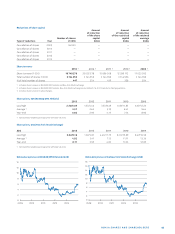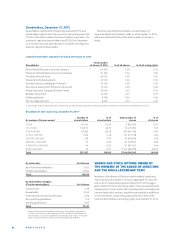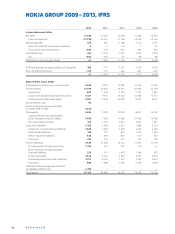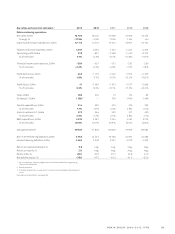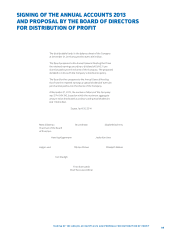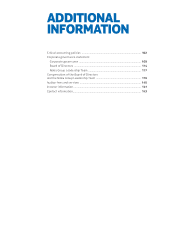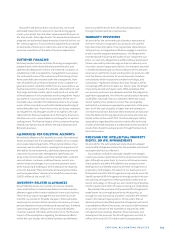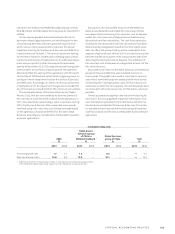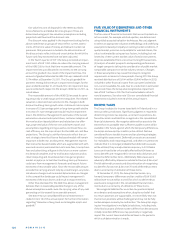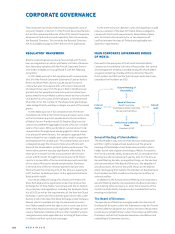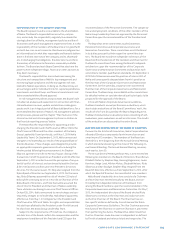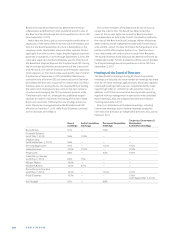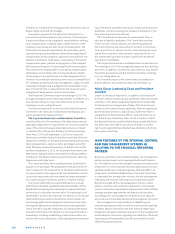Nokia 2013 Annual Report Download - page 105
Download and view the complete annual report
Please find page 105 of the 2013 Nokia annual report below. You can navigate through the pages in the report by either clicking on the pages listed below, or by using the keyword search tool below to find specific information within the annual report.103
CRITICAL ACCOUNTING POLICIES
Also within the Devices & Services business, we record
estimated reductions to revenue for special pricing agree-
ments, price protection and other volume based discounts at
the time of sale. Sales adjustments for volume based discount
programs are estimated largely based on historical activity un-
der similar programs. Price protection adjustments are based
on estimates of future price reductions and certain agreed
customer inventories at the date of the price adjustment.
CUSTOMER FINANCING
We have provided certain customer fi nancing arrangements,
predominantly within Nokia Solutions and Networks, and
agreed extended payment terms with selected customers. In
establishing credit arrangements, management must assess
the creditworthiness of the customer and the timing of cash
fl ows expected to be received under the arrangement. How-
ever, should the actual fi nancial position of our customers or
general economic conditions diff er from our assumptions, we
may be required to reassess the ultimate collectability of such
fi nancings and trade credits, which could result in a write-off
of these balances in future periods and thus negatively impact
our profi ts in future periods. Our assessment of the net re-
coverable value considers the collateral and security arrange-
ments of the receivable as well as the likelihood and timing of
estimated collections. From time to time, the Group endeavors
to mitigate this risk through transfer of its rights to the cash
collected from these arrangements to third-party fi nancial in-
stitutions on a non-recourse basis in exchange for an upfront
cash payment. The fi nancial impact of the customer fi nancing
related assumptions mainly aff ects the Nokia Solutions and
Networks business.
ALLOWANCES FOR DOUBTFUL ACCOUNTS
We maintain allowances for doubtful accounts for estimated
losses resulting from the subsequent inability of our custom-
ers to make required payments. If fi nancial conditions of our
customers were to deteriorate, resulting in an impairment of
their ability to make payments, additional allowances may be
required in future periods. Management specifi cally ana-
lyzes accounts receivables and historical bad debt, customer
concentrations, customer creditworthiness, current eco-
nomic trends and changes in our customer payment terms
when evaluating the adequacy of the allowance for doubtful
accounts. Based on these estimates and assumptions Nokia
continuing operations’ allowance for doubtful accounts was
EUR million at the end of .
INVENTORY-RELATED ALLOWANCES
We periodically review our inventory for excess, obsoles-
cence and declines in market value below cost and record an
allowance against the inventory balance for any such declines.
These reviews require management to estimate future de-
mand for our products. Possible changes in these estimates
could result in revisions to the valuation of inventory in future
periods. Based on these estimates and assumptions, the Nokia
continuing operations’ allowance for excess and obsolete
inventory was EUR million at the end of . The fi nancial
impact of the assumptions regarding this allowance aff ects
mainly the cost of sales of the Nokia Solutions and Networks
business and the results from discontinued operations
through the Devices & Services business.
WARRANTY PROVISIONS
We provide for the estimated cost of product warranties at
the time revenue is recognized. Our products are covered
by product warranty plans of varying periods, depending on
local practices and regulations. While we engage in extensive
product quality programs and processes, including actively
monitoring and evaluating the quality of our component sup-
pliers, our warranty obligations are aff ected by actual product
failure rates and by material usage and service delivery costs
incurred in correcting a product failure. Our warranty provision
is established based upon our best estimates of the amounts
necessary to settle future and existing claims on products sold
as of the balance sheet date. As we continuously introduce
new products which incorporate complex technology, and
as local laws, regulations and practices may change, it will be
increasingly diffi cult to anticipate our failure rates, the length
of warranty periods and repair costs. While we believe that
our warranty provisions are adequate and that the judgments
applied are appropriate, the ultimate cost of product warranty
could diff er materially from our estimates. When the actual
cost of quality of our products is lower than we originally
anticipated, we release an appropriate proportion of the provi-
sion, and if the cost of quality is higher than anticipated, we
increase the provision. Based on these estimates and assump-
tions the Nokia continuing operations warranty provision was
EUR million at the end of . The fi nancial impact of the
assumptions regarding this provision mainly aff ects the cost
of sales of the Nokia Solutions and Networks business and the
results from discontinued operations through the Devices &
Services business.
PROVISION FOR INTELLECTUAL PROPERTY
RIGHTS, OR IPR, INFRINGEMENTS
We provide for the estimated past costs related to alleged
asserted IPR infringements based on the probable outcome of
each potential future settlement.
Our products include increasingly complex technologies
involving numerous patented and other proprietary technolo-
gies. Although we proactively try to ensure that we are aware
of any patents and other IPR related to our products under
development and thereby avoid inadvertent infringement of
proprietary technologies, the nature of our business is such
that patent and other IPR infringements may and do occur. We
identify potential IPR infringements through contact with par-
ties claiming infringement of their patented or otherwise ex-
clusive technology, or through our own monitoring of develop-
ments in patent and other IPR cases involving our competitors.
We estimate the outcome of all potential IPR infringements
made known to us through assertion by third parties, or
through our own monitoring of patent- and other IPR-related
cases in the relevant legal systems. To the extent that we
determine that an identifi ed potential infringement will result
in a probable outfl ow of resources, we record a liability based
on our best estimate of the expenditure required to settle
infringement proceedings. Based on these estimates and
assumptions the provision for IPR infringements was EUR
million at the end of in Nokia continuing operations.


